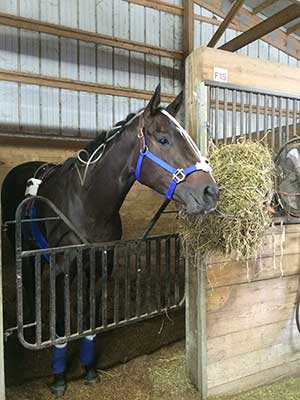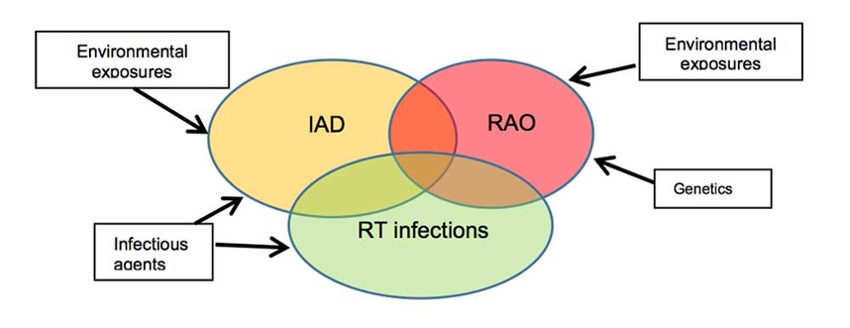Research
Inflammatory Airway Disease in Thoroughbred Racehorses

As the most common airway disease of athletic horses, IAD is particularly prevalent in racehorses. While the degree of airway inflammation in cases of IAD is usually mild, with horses appearing normal at rest and during training, the disease is an important cause of poor performance. Impaired gas exchange in the lungs of horses with IAD and the frequency with which cases go unrecognized raise welfare concerns. Presumptive diagnosis of IAD is often based upon endoscopic demonstration of excess tracheal mucus and a history of poor performance or intermittent coughing. Because the etiology of IAD is incompletely understood and is presumed to be multifactorial, equine veterinarians have no proven prevention or treatment plans to prescribe. As a result, treatment of IAD with antimicrobials is widespread, introducing the risk of drug violations in racing horses, antimicrobial resistance, and potentially life-threatening antimicrobial-induced diarrhea. Our Grayson Jockey Club Research Foundation funded project seeks to compare the relative importance of environmental exposures, respiratory bacterial populations, and viruses in IAD as well as establishing a link between BALF inflammatory cell populations and performance. This work will help pave the way for instigations into the efficacy of environmental interventions, antimicrobials, and immune modulators in restoring a healthy respiratory tract.
Thoroughbreds racing in Indiana are eligible to enroll in the study. If you are interested in participating, please contact Dr. Ivester by email at kivester@purdue.edu or by phone at 765-494-8548.
Local Bronchial Mold Challenge

Recurrent airway obstruction (RAO), also known as severe equine asthma or heaves is the most common chronic respiratory disease in adult horses. Exposure of RAO-susceptible horses to moldy hay is known to induce exacerbation of clinical disease. The proposed mechanism is that antigens present in inhaled molds bind to antibodies (e.g. IgG, IgE) present in epithelial lining fluid of RAO-susceptible horses resulting in airway inflammation and obstruction. Various species of fungi and fungal-like organisms such as A. fumigatus and F. rectivirgula are particularly abundant in moldy hay and RAO horses have a higher concentration of fungal specific antibodies against those fungi in bronchoalveolar lavage fluid (BALF).[7,8] However, whether these fungi or other species are responsible for disease exacerbation in a particular RAO horse is currently unknown. Recently, we showed that among the many fungi that may be cultured from inhalable dust collected during moldy hay challenge of RAO horses, four fungal species (Alternaria alternata, Aspergillus terreus, Eurotium amstelodami, and Wallemia sebi) resulted in strong binding with BALF antibodies from asthmatic horses but not control horses, strongly suggesting that A alternata, A terreus, E amstelodami, and W sebi play a role in RAO pathogenesis. This study will characterize the pulmonary response of RAO- susceptible horses to intra-bronchial allergen challenge with mold culture extracts from these fungal species by measuring airway inflammatory cells and lung function.

Selected Publications
- Inflammatory Airway Disease of Horses-Revised Consensus Statement. Couëtil LL, Cardwell JM, Gerber V, Lavoie JP, Léguillette R, Richard EA.J Vet Intern Med. 2016 Jan 24.
- Secretoglobin and Transferrin Expression in Bronchoalveolar Lavage Fluid of Horses with Chronic Respiratory Disease. Miskovic Feutz M, Couetil LL, Riley CP, Zhang X, Adamec J, Raskin RE. J Vet Intern Med. 2015 Nov;29(6):1692-9.
- Exercise induced pulmonary hemorrhage in horses: American College of Veterinary Internal Medicine consensus statement. Hinchcliff KW, Couetil LL, Knight PK, Morley PS, Robinson NE, Sweeney CR, van Erck E. J Vet Intern Med. 2015 May-Jun;29(3):743-58.
- Omega-3 fatty acid supplementation provides an additional benefit to a low-dust diet in the management of horses with chronic lower airway inflammatory disease. Nogradi N, Couetil LL, Messick J, Stochelski MA, Burgess JR. J Vet Intern Med. 2015 Jan;29(1):299-306.
- Investigating the link between particulate exposure and airway inflammation in the horse. Ivester KM, Couëtil LL, Zimmerman NJ. J Vet Intern Med. 2014 Nov-Dec;28(6):1653-65.
- Environmental exposures and airway inflammation in young thoroughbred horses. Ivester KM, Couëtil LL, Moore GE, Zimmerman NJ, Raskin RE. J Vet Intern Med. 2014 May-Jun;28(3):918-24.
- Comparison of genomic and proteomic data in recurrent airway obstruction affected horses using Ingenuity Pathway Analysis®. Racine J, Gerber V, Feutz MM, Riley CP, Adamec J, Swinburne JE, Couetil LL. BMC Vet Res. 2011 Aug 15;7:48.
- Comparative efficacy of inhaled albuterol between two hand-held delivery devices in horses with recurrent airway obstruction. Bertin FR, Ivester KM, Couëtil LL. Equine Vet J. 2011 Jul;43(4):393-8.
- Efficacy and safety of sound wave treatment of recurrent airway obstruction in horses. Goncarovs KO, Miskovic Feutz M, Perez-Moreno C, Couetil LL. J Vet Intern Med. 2010 Nov-Dec;24(6):1503-8.

